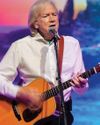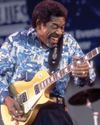
Welcome to this unabashed celebration of rock guitar. The aim of the lesson is to provide you with some core concepts and techniques which will help you build a really good vocabulary in a whole range of rock guitar styles.
The guitar is one of the key instruments in the rock ensemble; it provides much of the harmonic backing and of course is also used to play riffs, fills and solos. Some rock bands are three-piece outfits where the guitar provides the majority of the melodic and harmonic content. Other line-ups include guitar and keyboards working in tandem. Then there are twin-guitar assaults, either with or without keys. All these band types require subtly diffferent ways of interacting with the other musicians, and we will see many of these approaches in the following 50 licks.
Many of the greatest rock songs are written in guitar-friendly keys like G, A, E and D and this allows the guitarist to utilise various open strings and resonant, first-position chords. When creating riffs, lead lines and guitar solos the Major and Minor Pentatonic scales are a popular starting point, and many of our examples use these as their basis. Both of scales are constructed from five notes, with the intervals as follows:
MANY OF THE GREATEST ROCK SONGS ARE WRITTEN IN GUITAR-FRIENDLY KEYS THAT ALLOW THE GUITARIST TO UTILISE VARIOUS OPEN STRINGS
Major Pentatonic: R-2-3-5-6.
Minor Pentatonic: R-b3-4-5-b7.
The Major and Minor triad arpeggios are also commonly employed. Their intervals are: Major triad arpeggio: R-3-5. Minor triad arpeggio: R-b3-5.
Bu hikaye Guitar Techniques dergisinin December 2020 sayısından alınmıştır.
Start your 7-day Magzter GOLD free trial to access thousands of curated premium stories, and 9,000+ magazines and newspapers.
Already a subscriber ? Giriş Yap
Bu hikaye Guitar Techniques dergisinin December 2020 sayısından alınmıştır.
Start your 7-day Magzter GOLD free trial to access thousands of curated premium stories, and 9,000+ magazines and newspapers.
Already a subscriber? Giriş Yap

THE MOODY BLUES
This month Stuart Ryan delves into the picking style of this British prog legend whose acoustic guitar has powered many a Moody Blues song.

WAYNE KRANTZ
This issue Nick Mellor provides an insight into this brilliant jazz stylist, focusing on his approach to improvising over static chords.

OPEN G TUNING
Open tunings are great fun and can help create exciting new ideas. Simon Barnard shows how to incorporate open G tuning into your playing.

RODRIGO GOUVEIA
Last month we featured Mateus Asato, and mentioned the importance of the neo-soul style in his playing. Here we turn to his fellow Brazilian, the master of neo-soul fusion.

MARK KNOPFLER
Our topic this month is a master craftsman as both guitar player and songwriter. His style is unique and his influence spreads far and wide.

U2
Martin Cooper checks out the chiming pedal delay tones of this stadium-filling band from Dublin, Ireland, and guitarist The Edge.

LUTHER ALLISON
It’s blues with a touch of soul this month, as David Gerrish explores the dynamic, expressive style of an often overlooked Chicago bluesman.

JOHANN KASPAR MERTZ Capriccio
This month Declan Zapala explores the music of Austria at the turn of the Romantic period with a fiery caprice to level up your fingers and unlock your inner virtuoso.

THE CROSSROADS Michael Landau
John Wheatcroft explores the playing of a session ace _ and blazing blues-rock maestro who graces the top-flight m band of singer-songwriting legend, James Taylor.

VIDEO MASTERCLASS Troy Redfern
This month GT welcomes this slide guitar virtuoso. If you've been wanting to take your slide playing to the next level then this is one's for you. With Jon Bishop.